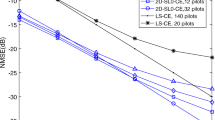Abstract
Massive spatial modulation (MSM) is considered as an attractive technique for multi antenna wireless communications. That is because, it gives higher energy efficiency and spectral efficiency than small scale multiple-input multiple-output (MIMO) systems. Massive SM-MIMO utilizes multiple transmit antennas for each user with only one transmit radio frequency (RF) chain and hundreds of receive antennas at base station (BS) with small number of RF chain. Where, each user can activate any one of its transmit antennas and the index of active transmit antenna (TA) can convey to information bits in addition to the information bits conveyed through classical modulation symbols (e.g. 16QAM). Owing to large number of TAs at the user and small number of RF chains at BS, multi user signal detection becomes challenging problem. To solve this matter, a joint grouped SM transmission scheme at users and group subspace pursuit (GSP) based signal detection at BS can be proposed to improve the signal detection performance. Owing to joint transmission scheme, SM signals in same transmission group exhibit group sparsity. Also, spatial signal composed of multiple users’ SM signals exhibits distributed sparsity. By utilizing these sparse features, the proposed GSP based signal detection can detect SM signals more reliability than other detection techniques. Additionally, the cyclic prefix single carrier (CPSC) is utilized to withstand the multipath channels. Simulation results prove that BER performance of the proposed GSP based signal detection outperforms classical SP based signal detection by 8 dB SNR gain at BER = 10−2. This gain can be improved by 2 dB by increasing the number of transmit antenna.









Similar content being viewed by others
References
N. Ishikawa, R. Rajashekar, S. Sugiwra and L. Hanzo, Generalized spatial modulation based reduced RF chain millimeter wave communications, IEEE Trans Veh Technology., Vol. 66, No. 1, pp. 879–883, 2017.
X. Gao, L. Dai and A. M. Sayeed, Low RF-complexity technologies to enable millimeter-wave MIMO with large antenna array for 5G wireless communications, IEEE Communication Mag., Vol. 56, No. 4, pp. 211–217, 2018.
P. Yang, et al., Adaptive SM-MIMO for mmWave communications with reduced RF chains, IEEE J. Sel. Areas Communication, Vol. 35, No. 7, pp. 1472–1485, 2017.
N. Ishikawa, et al., Generalized spatial modulation based reduced RF-chain millimeter-wave communications, IEEE Trans. Vehicular Technology, Vol. 66, No. 1, pp. 879–883, 2017.
A. Raafat, A. Agustin, J. Vidal, Receive spatial modulation for massive MIMO systems. IEEE Global Communication Conference. 2017.
L. He, J. Wang and J. Song, On generalized spatial modulation aided millimeter wave MIMO: spectral efficiency analysis and hybrid precoder design, IEEE Trans. Wireless Communication, Vol. 16, No. 11, pp. 7658–7671, 2017.
W. Ren, G. Gui, and F.Li, Normalized structured compressed sensing based signal detection in spatial modulation 3D–MIMO Systems. Wireless Communications and Mobile Computing. 2017.
Z. Gao, L. Dai, Z. Wang, S. Chen and L. Hanzo, Compressive-sensing-based multiuser detector for the large-scale SM-MIMO uplink, IEEE Transactions on Vehicular Technology, Vol. 65, No. 10, pp. 8725–8730, 2016.
A. Stavros, M. D. Renzo, P. M. Grant, et al., Performance analysis of receive space modulation in the shadowing MIMO broadcast channel, IEEE Transactions Communication., Vol. 65, No. 5, pp. 1972–1983, 2017.
R. W. Heath Jr., et al., An overview of signal processing techniques for millimeter wave MIMO systems, IEEE J. Sel. Topics Signal Processing, Vol. 10, No. 3, pp. 436–453, 2016.
P. Yang, et al., Single-carrier spatial modulation: A promising design for large-scale broadband antenna systems, IEEE Communication Surveys Tuts., Vol. 18, No. 3, pp. 1687–1716, 2016.
S. Said, W. Saad and M. Shokair, MMSE algorithm based two stages hybrid precoding for millimeter wave massive MIMO systems, Analog Integrated Circuits and Signal Processing Journal., Vol. 98, No. 3, pp. 565–573, 2019.
A. Younis, N. Abuzgaia and H. Haas, Quadrature spatial modulation for 5G outdoor millimeter-wave communications: capacity analysis, IEEE Trans. Wireless Communication, Vol. 16, No. 5, pp. 2882–2890, 2017.
Z. Gao, L. Dai, C. Qi, C. Yuen and Z. Wang, Near-optimal signal detector based on structured compressive sensing for massive SM-MIMO, IEEE Transactions on Vehicular Technology, Vol. 66, No. 2, pp. 1860–1865, 2017.
W. Ren, G. Gui, and F. Li, Performance evaluation of structured compressed sensing based signal detection in spatial modulation 3D MIMO systems. In: Proceedings of the in International Conference on Advanced Hybrid Information Processing (ADHIP), pp. 1–9, Harbin, China (2017).
W. Ni, X. Dong and W. S. Lu, Near-optimal hybrid processing for massive MIMO systems via matrix decomposition, IEEE Transactions Signal Process, Vol. 65, No. 15, pp. 3922–3933, 2017.
E. Bjorson, E. G. Larsson and M. Debbah, Massive MIMO for maximal spectral efficiency: How many users and pilots should be allocated?, IEEE Transactions Wireless Communications, Vol. 15, No. 2, pp. 1293–1308, 2016.
E. Basar, M. Wen, and R. Mesleh,” Index modulation for next generation wireless networks,” IEEE access, vol. 5, No. 99, 2017.
S. Lu, I. Hemadeh, M. El-Hajjar and L. Hanzo, Compressed sensing aided space time frequency index modulation, IEEE Transactions on Vehicular Technology, Vol. 67, No. 7, pp. 6259–6271, 2018.
Author information
Authors and Affiliations
Corresponding author
Additional information
Publisher's Note
Springer Nature remains neutral with regard to jurisdictional claims in published maps and institutional affiliations.
Rights and permissions
About this article
Cite this article
Said, S., Saad, W., Shokair, M. et al. BER Performance of Signal Detection for Massive Multi User Spatial Modulation Systems. Int J Wireless Inf Networks 27, 484–493 (2020). https://doi.org/10.1007/s10776-020-00484-6
Received:
Revised:
Accepted:
Published:
Issue Date:
DOI: https://doi.org/10.1007/s10776-020-00484-6




